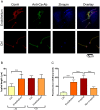Candida albicans scavenges host zinc via Pra1 during endothelial invasion
- PMID: 22761575
- PMCID: PMC3386192
- DOI: 10.1371/journal.ppat.1002777
Candida albicans scavenges host zinc via Pra1 during endothelial invasion
Abstract
The ability of pathogenic microorganisms to assimilate essential nutrients from their hosts is critical for pathogenesis. Here we report endothelial zinc sequestration by the major human fungal pathogen, Candida albicans. We hypothesised that, analogous to siderophore-mediated iron acquisition, C. albicans utilises an extracellular zinc scavenger for acquiring this essential metal. We postulated that such a "zincophore" system would consist of a secreted factor with zinc-binding properties, which can specifically reassociate with the fungal cell surface. In silico analysis of the C. albicans secretome for proteins with zinc binding motifs identified the pH-regulated antigen 1 (Pra1). Three-dimensional modelling of Pra1 indicated the presence of at least two zinc coordination sites. Indeed, recombinantly expressed Pra1 exhibited zinc binding properties in vitro. Deletion of PRA1 in C. albicans prevented fungal sequestration and utilisation of host zinc, and specifically blocked host cell damage in the absence of exogenous zinc. Phylogenetic analysis revealed that PRA1 arose in an ancient fungal lineage and developed synteny with ZRT1 (encoding a zinc transporter) before divergence of the Ascomycota and Basidiomycota. Structural modelling indicated physical interaction between Pra1 and Zrt1 and we confirmed this experimentally by demonstrating that Zrt1 was essential for binding of soluble Pra1 to the cell surface of C. albicans. Therefore, we have identified a novel metal acquisition system consisting of a secreted zinc scavenger ("zincophore"), which reassociates with the fungal cell. Furthermore, functional similarities with phylogenetically unrelated prokaryotic systems indicate that syntenic zinc acquisition loci have been independently selected during evolution.
Conflict of interest statement
The authors have declared that no competing interests exist.
Figures










Similar articles
-
Candida albicans zincophore and zinc transporter interactions with Zn(ii) and Ni(ii).Dalton Trans. 2018 Feb 20;47(8):2646-2654. doi: 10.1039/c7dt04403h. Dalton Trans. 2018. PMID: 29405215
-
Candida albicans Sap6 amyloid regions function in cellular aggregation and zinc binding, and contribute to zinc acquisition.Sci Rep. 2017 Jun 6;7(1):2908. doi: 10.1038/s41598-017-03082-4. Sci Rep. 2017. PMID: 28588252 Free PMC article.
-
Association of the hypha-related protein Pra1 and zinc transporter Zrt1 with biofilm formation by the pathogenic yeast Candida albicans.Microbiol Immunol. 2018 Jun;62(6):405-410. doi: 10.1111/1348-0421.12596. Microbiol Immunol. 2018. PMID: 29704397
-
Pan-Domain Analysis of ZIP Zinc Transporters.Int J Mol Sci. 2017 Dec 6;18(12):2631. doi: 10.3390/ijms18122631. Int J Mol Sci. 2017. PMID: 29211002 Free PMC article. Review.
-
Immune escape of the human facultative pathogenic yeast Candida albicans: the many faces of the Candida Pra1 protein.Int J Med Microbiol. 2011 Jun;301(5):423-30. doi: 10.1016/j.ijmm.2011.04.010. Epub 2011 May 11. Int J Med Microbiol. 2011. PMID: 21565550 Review.
Cited by
-
HcZrt2, a zinc responsive gene, is indispensable for the survival of Histoplasma capsulatum in vivo.Med Mycol. 2016 Nov 1;54(8):865-75. doi: 10.1093/mmy/myw045. Epub 2016 Jun 22. Med Mycol. 2016. PMID: 27335059 Free PMC article.
-
Two unlike cousins: Candida albicans and C. glabrata infection strategies.Cell Microbiol. 2013 May;15(5):701-8. doi: 10.1111/cmi.12091. Epub 2013 Jan 14. Cell Microbiol. 2013. PMID: 23253282 Free PMC article. Review.
-
Comparative genomics of Cryptococcus and Kwoniella reveals pathogenesis evolution and contrasting karyotype dynamics via intercentromeric recombination or chromosome fusion.bioRxiv [Preprint]. 2024 Jan 13:2023.12.27.573464. doi: 10.1101/2023.12.27.573464. bioRxiv. 2024. Update in: PLoS Biol. 2024 Jun 6;22(6):e3002682. doi: 10.1371/journal.pbio.3002682. PMID: 38234769 Free PMC article. Updated. Preprint.
-
Fungal zinc metabolism and its connections to virulence.Front Cell Infect Microbiol. 2013 Oct 14;3:65. doi: 10.3389/fcimb.2013.00065. eCollection 2013. Front Cell Infect Microbiol. 2013. PMID: 24133658 Free PMC article. Review.
-
Zinc sequestration: arming phagocyte defense against fungal attack.PLoS Pathog. 2013;9(12):e1003815. doi: 10.1371/journal.ppat.1003815. Epub 2013 Dec 26. PLoS Pathog. 2013. PMID: 24385902 Free PMC article. Review. No abstract available.
References
-
- Andreini C, Bertini I, Rosato A. Metalloproteomes: a bioinformatic approach. Acc Chem Res. 2009;42:1471–1479. - PubMed
-
- Corbin BD, Seeley EH, Raab A, Feldmann J, Miller MR, et al. Metal chelation and inhibition of bacterial growth in tissue abscesses. Science. 2008;319:962–965. - PubMed
-
- Perlroth J, Choi B, Spellberg B. Nosocomial fungal infections: epidemiology, diagnosis, and treatment. Med Mycol. 2007;45:321–346. - PubMed
Publication types
MeSH terms
Substances
LinkOut - more resources
Full Text Sources
Other Literature Sources
Medical
Molecular Biology Databases

